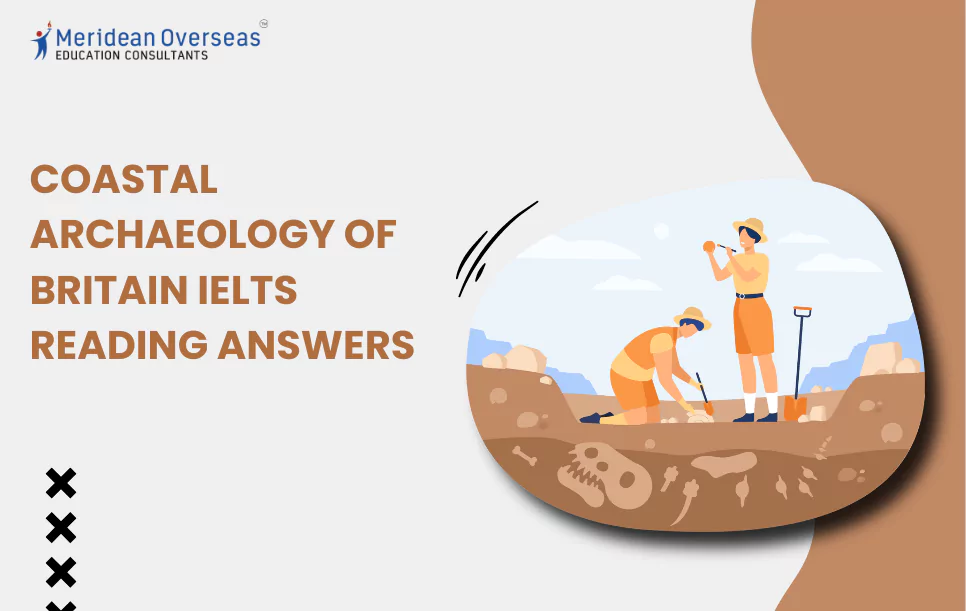
Announcements

Announcements

Meridean Overseas
Updated On 31 August 2024 & Read Time 16 minutes
3.3k
Students often find the reading section difficult and are not able to answer it properly within the given time. Do you know the second part of the IELTS exam is the reading section? If no, then this blog is for you.

In the IELTS reading section, you will have to read three text passages and respond to forty questions in one hour and sixty minutes. Further, you will only have a little time to copy your answers onto the answer sheets, so read them thoroughly.
In this blog post, we've provided a sample reading passage on the topic “Coastal Archaeology of Britain” so you can practice and increase your IELTS reading section score.
Table of Contents
Time management is essential because you have 60 minutes to finish the 40 test questions. The reading test encompasses three portions, and you should try to spend no more than 20 minutes on each one.
The recognition of the wealth and diversity of England’s coastal archaeology has been one of the most important developments of recent years. Some elements of this enormous resource have long been known. The so-called ‘submerged forests’ off the coasts of England, sometimes with clear evidence of human activity, had attracted the interest of antiquarians since at least the eighteenth century, but serious and systematic attention has been given to the archaeological potential of the coast only since the early 1980s.
It is possible to trace a variety of causes for this concentration of effort and interest. In the 1980s and 1990s, scientific research into climate change and its environmental impact spilt over into a much broader public debate as awareness of these issues grew; the prospect of rising sea levels over the next century and their impact on current coastal environments has been a particular focus for concern. At the same time, archaeologists were beginning to recognise that the destruction caused by natural processes of coastal erosion and by human activity was having an increasing impact on the archaeological resources of the coast.
The dominant process affecting the physical form of England in the post-glacial period has been rising in the altitude of sea level relative to the land as the glaciers melted and the landmass readjusted. The encroachment of the sea, the loss of huge areas of land now under the North Sea and the English Channel, and especially the loss of the land bridge between England and France, which finally made Britain an island, must have been immensely significant factors in the lives of our prehistoric ancestors. Yet the way in which prehistoric communities adjusted to these environmental changes has seldom been a major theme in discussions of the period. One factor contributing to this has been that, although the rise in relative sea level is comparatively well documented, we know little about the constant reconfiguration of the coastline. This was affected by many processes, mostly quiet, which have not yet been adequately researched. The detailed reconstruction of coastline histories and the changing environments available for human use will be an important theme for future research.
So great has been the rise in sea level and the consequent regression of the coast that much of the archaeological evidence is now exposed in the coastal zone. Whether being eroded or exposed as a buried land surface is derived from what was originally terrestrial occupation. Its current location in the coastal zone is the product of later unrelated processes, and it can tell us little about past adaptations to the sea. Estimates of its significance will need to be made in the context of other related evidence from dry land sites. Nevertheless, its physical environment means that preservation is often excellent, for example, in the case of the Neolithic structure excavated at the Stumble in Essex.
In some cases, these buried land surfaces do contain evidence of human exploitation of what was a coastal environment, and elsewhere along the modern coast, there is similar evidence. Where the evidence does relate to past human exploitation of the resources and the opportunities offered by the sea and the coast, it is both diverse and, as yet, little understood. We are not yet in a position to make even preliminary estimates of answers to such fundamental questions as the extent to which the sea and the coast affected human life in the past, what percentage of the population at any time lived within reach of the sea, or whether human settlements in coastal environments showed a distinct character from those inland.
The most striking evidence for the use of the sea is in the form of boats, yet we still have much to learn about their production and use. Most of the known wrecks around our coast are not unexpectedly of post-medieval date and offer an unparalleled opportunity for research that has yet been little used. The prehistoric sewn-plank boats, such as those from the Humber estuary and Dover, all seem to belong to the second millennium BC; after this, there is a gap in the record of a millennium, which cannot yet be explained before boats reappear, but it built using a very different technology. Boatbuilding must have been an extremely important activity around much of our coast, yet we know almost nothing about it. Boats were some of the most complex artefacts produced by pre-modem societies, and further research on their production and use make an important contribution to our understanding of past attitudes to technology and technological change.
Boats need landing places, yet here again, our knowledge is very patchy. In many cases, the natural shores and beaches would have sufficed, leaving little or no archaeological trace, but especially in later periods, many ports and harbours, as well as smaller facilities such as quays, wharves, and jetties, were built. Despite a growth of interest in the waterfront archaeology of some of our more important Roman and medieval towns, very little attention has been paid to the multitude of smaller landing places. The redevelopment of harbour sites and other development and natural pressures along the coast are subject to unprecedented threats in these important locations, yet few surveys of such sites have been undertaken.
One of the most important revelations of recent research has been the extent of industrial activity along the coast. Fishing and salt production are among the better-documented activities, but even here, our knowledge is patchy. Many forms of fishing will leave little archaeological trace, and one of the surprises of the recent survey has been the extent of past investment in facilities for procuring fish and shellfish. Elaborate wooden fish weirs, often of considerable extent and responsive to aerial photography in shallow water, have been identified in areas such as Essex and the Severn estuary. The production of salt, especially in the late Iron Age and early Roman periods, has been recognised for some time, especially in the Thames estuary and around the Solent and Poole Harbor, but the reasons for the decline of that industry and the nature of later coastal salt working are much less well understood. Other industries were also located along the coast, either because the raw materials outcropped there or for ease of working and transport: mineral resources such as sand, gravel, stone, coal, ironstone, and alum were all exploited. These industries are poorly documented, but their remains are sometimes extensive and striking.
Some appreciation of the variety and importance of the archaeological remains preserved in the coastal zone, albeit only in preliminary form, can thus be gained from recent work, but the complexity of the problem of managing that resource is also being realised. The problem arises not only from the scale and variety of the archaeological remains but also from two other sources: the very varied natural and human threats to the resource and the complex web of organisations with authority over, or interests in, the coastal zone. Human threats include the redevelopment of historic towns and old dockland areas and the increased importance of the coast for the leisure and tourism industries, resulting in pressure for the increased provision of facilities such as marinas. The larger size of ferries has also caused an increase in the damage caused by their wash to fragile deposits in the intertidal zone. The most significant natural threat is the predicted rise in sea level over the next century, especially in the south and east of England. Its impact on archaeology is not easy to predict, and though it is likely to be highly localised, it will be at a scale much larger than that of most archaeological sites. Thus, protecting one site may simply result in transposing the threat to a point further along the coast. The management of the archaeological remains will have to be considered on a much longer time scale and a much wider geographical scale than is common in the case of dry land sites, and this will pose a serious challenge for archaeologists.
Get free IELTS Sample Papers to learn the type of questions asked in the IELTS (Speaking, writing, reading, and listening) section.
Download Now!Questions 1-3
Choose the right answer from A, B, C, and D.
1. What, in particular, has recently piqued popular interest in coastal archaeology?
The shoreline archaeology of England has developed quickly.
Increasing knowledge of climate change
An undersea forest has been found.
Systematic analysis of coastal archaeological discoveries
2. What does the passage have to say about the boat-related evidence?
The technique used by prehistoric people to create boats is sufficiently known.
Many of the recovered boats were discovered in harbours.
The last time boats were used was 1,000 years ago.
Fishing was the initial use of boats.
3. What can be learned through flying?
A salt mine
Roman cities
Harbours
Fisheries
Questions 4-10
Which of the following claims are true regarding the information in the reading passage? Write the answer in boxes 4–10 on the sheet.
TRUE if the statement agrees with the information
FALSE if the statement contradicts the information
NOT GIVEN if there is no information on this
4. As a result of the sea level rising after the glacial period, England lost a lot of its territory.
5. England’s shoreline has undergone periodic modification.
6. Seawater may provide good protection for coastal archaeological material.
7. Pre-modern humans utilised very basic boats with very rudimentary designs.
8. Many other European nations also had similar boats that were found.
9. There are not many papers on mineral utilisation.
10. The coastline is becoming increasingly damaged by large passenger vessels.
Questions 11-13
Pick three statements listed in the paragraph, ranging from A to G. You have to select three from the six statements listed in the paragraph (A-G) for this question.
How coastal archaeology came to be known
It is challenging to comprehend how many people live near the ocean.
How well did ancient societies understand the effects of climate change
We don’t know a lot about boat evidence.
Ports have been built on several former fishing grounds.
The archaeological remnants are in danger of human development.
Future developments will increase the significance of coastal archaeology.
Also, Read: Mastering the IELTS Band Score: How to Achieve an 8 in All Sections
Answer 1-3
Increasing knowledge of climate change
From: Paragraph B, In the 1980s and 1990s, scientific research into climate change and its environmental impact spilt over into a much broader public debate as awareness of these issues grew; the prospect of rising sea levels over the next century and their impact on current coastal environments has been a particular focus for concern.
Explanation: Recently, interest in coastal archaeology has significantly improved due to growing awareness of climate change.
The last time boats were used was 1,000 years ago.
From: Paragraph F, the prehistoric sewn-plank boats, such as those from the Humber estuary and Dover, all seem to belong to the second millennium BC; after this, there is a gap in the record of a millennium, which cannot yet be explained before boats reappear, but it built using a very different technology.
Explanation: It's interesting to note that prehistoric woven plank boats emerged, and the recent revival of boats in Britain occurred roughly a millennium ago. The cause of this gap is still unknown and has not yet been clarified.
Fisheries
From: Paragraph H, Elaborate wooden fish weirs, often of considerable extent and responsive to aerial photography in shallow water, have been identified in areas such as Essex and the Severn estuary.
Explanation: In coastal archaeology, aerial photography has been used to identify fish and submerged remains. Thus, it can be said that it had been used for fishing in places like Essex and the Severn Estuary.
Answer 4-10
True
From: Paragraph C, The encroachment of the sea, the loss of huge areas of land now under the North Sea and the English Channel, and especially the loss of the land bridge between England and France, which finally made Britain an island, must have been immensely significant factors in the lives of our prehistoric ancestors.
Explanation: The answer is Yes since the post-glacial statement states that the thawing of glaciers raised sea levels, which in turn caused England's landmass to shift again. As a result, considerable land was lost beneath the English Channel and the North Sea, and the land bridge connecting France and England vanished, turning Britain into an island.
False
From: Paragraph C, The detailed reconstruction of coastline histories and the changing environments available for human use will be an important theme for future research.
Explanation: The paragraph mostly discusses detailed reconstruction and how it altered the physical form of England during the post-glacial period, with little information on the periodic change occurring along England's shoreline. Thus, the response is false.
True
From: Paragraph D, So great has been the rise in sea level and the consequent regression of the coast that much of the archaeological evidence is now exposed in the coastal zone.
Explanation: The paragraph states that the coast has retreated due to rising sea levels, which has exposed and preserved a large amount of archaeological evidence in coastal zones. Therefore, the answer is indeed true.
False
From: Paragraph D, Boats were some of the most complex artefacts produced by pre-modem societies, and further research on their production and use make an important contribution to our understanding of past attitudes to technology and technological change.
Explanation: The response is false because the passage states that boats, not simple boats with crude designs, were the most sophisticated creations of pre-modern society.
Not Given
From: Not Given
Explanation: The passage requires information regarding similar boats that can be found in other European countries; hence, the answer is Not Given.
True
From: Paragraph H, These industries are poorly documented, but their remains are sometimes extensive and striking.
Explanation: The paragraph claims that alum, coal, and stone are only a few mineral resources that are heavily exploited. These sectors require thorough documentation, yet several documents are available. Thus, the answer is true.
True
From: Paragraph I, The larger size of ferries has also caused an increase in the damage caused by their wash to fragile deposits in the intertidal zone.
Explanation: The paragraph states that the answer is true since the enormous size of the ferries has harmed the deposits in the sea's intertidal zone.
Also, Read: Describe a new technological gadget you would like to buy
Answer 11-13
B
From: Paragraph E, We are not yet in a position to make even preliminary estimates of answers to such fundamental questions as the extent to which the sea and the coast affected human life in the past, what percentage of the population at any time lived within reach of the sea, or whether human settlements in coastal environments showed a distinct character from those inland.
Explanation: The paragraph claims that scientists still need assistance in fully comprehending basic issues regarding coastal regions, such as the proportion of the population that lives in coastal areas and the degree to which the sea and shore have influenced human life in the past.
D
From: Paragraph F, The most striking evidence for the use of the sea is in the form of boats, yet we still have much to learn about their production and use.
Explanation: According to the above statement, there is still much to learn about boats' historical use and construction. There is more to this topic than we now understand, and additional research can be done.
F
From: Paragraph I, Human threats include the redevelopment of historic towns and old dockland areas and the increased importance of the coast for the leisure and tourism industries, resulting in pressure for the increased provision of facilities such as marinas.
Explanation: Human activity poses the greatest hazard to archaeological artefacts. These risks include redevelopment, tourism, and the growing need for marinas. These actions risk destroying significant historical places and erasing priceless historical records.
Embark and excel in your study abroad journey with our expert team!

To conclude, you can enhance your content comprehension and respond to all questions by consistently practising various reading passage types. Take as many practice exams as possible on the sample reading assessments, which will help you receive an exceptional band score in the reading part
We hope you learned how to answer the IELTS reading passage. If you want to get further details or would like to prepare for IELTS, you may contact our expert counsellors at Meridean Overseas Education Consultants (MOEC). You can also take free online counselling through our website. Our expert counsellors will provide you with the best support and guidance you need for admission and visa. In addition, they will help you shortlist the universities according to your profile. For more information or any queries, contact application02@meridean.org or 1800-1230-00011.
Boost your IELTS score with effective practice using these sample papers.
Get Your Free Guide

Contact MOEC Experts for Study Abroad Guidance!
By using our site, you agree to our use of cookies.

Hurry up before admissions close.

